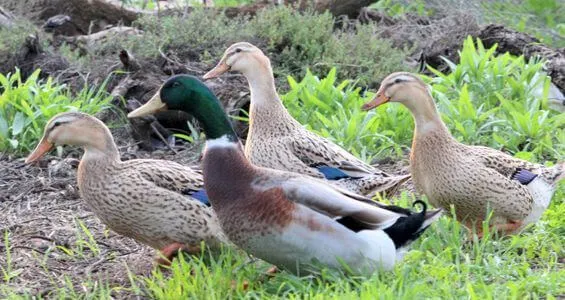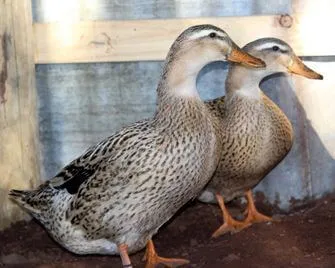This is not the Rouen duck. The Rouen Clair is a completely separate breed that has slipped out of the spotlight. It doesn’t lay enough to be mentioned in any “best egg layers” lists, and it isn’t meaty enough to be mentioned in any “best meat birds” lists. Upon hearing the name, people tend to assume it’s just another name for the Rouen. Its rarity doesn’t help anything, either.
However, the Rouen Clair is a fantastic utility breed that is definitely worth considering. They are primarily used for meat, as adult birds weigh between 6 and 9 pounds, but they are not bad egg layers. They can lay 150-200 eggs in a year, which is more than most Rouens can lay.

A flock of Rouen Clair ducks. Photo courtesy of Koljash Stud Waterfowl Farm.
They may not weigh as much as a Rouen or lay as much as a Welsh Harlequin, but they are comparable to the Pekin duck, one of the most popular dual-purpose breeds.
In addition, the Rouen Clair is a very calm bird, doesn’t fly, forages well, and some individuals make good mothers and broodies (although others do not). They are colored similar to a Mallard, but lighter, which is called “light phase Mallard” or “trout.” They are smaller and more upright than the Rouen, have longer bodies, and lack the Rouen’s voluminous keel.

Female Rouen Clair ducks. Photo courtesy of Koljash Stud Waterfowl Farm.
Rouen Clair ducks were developed by Monsieur Rene Garry around 1910-1920, in the Picardy region of France. His intention was to produce a large bird that would produce good meat, but would also lay well and be good for exhibition. Rouens and Mallards were both used in the creation of the Rouen Clair, as well as possibly Pekins.
As with many large, heavy breeds, the Rouen Clair may find it difficult to mate on land. Having a pond or other source of swimming water is advisable if you want to breed these birds.

Leave a comment
Your email address will not be published.